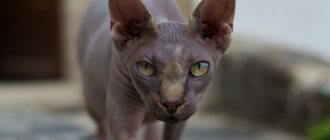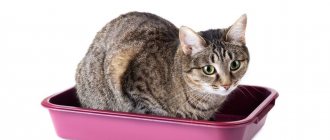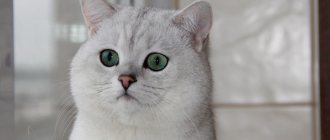In the last century, the age limit for cats rarely reached 10 years, and only a few lived to reach the 15-year mark. True, in those days the main task of cats was to protect food supplies from rodents. Hence injuries, infections and early death.
Now life expectancy for cats has increased significantly thanks to veterinary care, quality nutrition and a calmer lifestyle.
Average lifespan of a cat
Cats may not have nine lives, but factors such as diet, health and environment can influence how long they last. Neutered cats tend to live longer because neutering prevents reproductive diseases.
Although some pets depend on many things, including luck, they can live up to 20 years.
Over the course of their lives, they will go through six major life stages, which can help owners understand the specific health/behavioral issues that will arise. How long do sterilized cats live? 15-20 years.
Factors influencing health and longevity
According to experts, the quality of life of an animal directly affects its duration.
- Genetic properties of the breed. All breeding groups are divided into 3 categories - long-lived (maximum age 15 years or more), medium-lived (10-15 years) and the lowest level (less than 10 years). How long street cats live depends on the circumstances - among homeless animals there are also long-livers.
- Conditions of detention. The reasons for the reduction in life expectancy of cats may be an unsatisfactory living environment, for example, when the animal does not receive the necessary veterinary care.
- Nutrition. A high-quality diet and properly selected mineral and vitamin components can add a couple of active years to the life of domestic cats.
- Disease prevention. Each breed has a predisposition to certain ailments, and almost all cats also have heart and kidney problems. When neglected, these diagnoses are no longer curable and become chronic. Even young animals are not able to constantly cope with the resulting load and painful sensations. Such cats do not live long.
- Emotional background. The most subjective indicator, but many owners believe that life expectancy is influenced by the attitude of owners and family members, friendship with other four-legged pets, degree of training, general games and walks.
This is interesting! Among wild cat hybrids that live in enclosures, there are no long-livers.
Stages of life
The childhood period (kittens up to 3 months) is the best stage to introduce a cat to many new things, such as other pets, noise, cleaning and grooming, and children.
You will see them experience their fastest growth spurt during this time. This is also a good time to have your pet neutered to prevent unwanted litters.
Characteristics of a yard cat
| Attachment level | Average |
| Friendliness | Average |
| Suitable for children | Average |
| Loyalty to other pets | Average |
| Exercise needs | Average |
| Playfulness | Average |
| Energy level | Average |
| Intelligence | High |
| Tendency to meow | Average |
| Shedding intensity | Average |
Junior (six months - two years)
During this time, the cat will reach full size and reach sexual maturity. It is important to play properly with your pet as this will teach him to get along well with people.
This means that the owner should not play rough games with the cat; instead they use toys to interact with them. Playing with your hands can encourage biting and scratching.
Long-lived cats
Cream Puff with his owner
- The oldest cat named Cream Puff was included in the Guinness Book of Records because she lived for 38 years. This is the only officially confirmed case of longevity of a pet. The cat lived in America in the town of Austin, Texas, where she was born. The owner was Jake Perry, who pampered his pet with eggs, bacon, broccoli and asparagus. Cream Puff enjoyed enormous popularity, and even became the heroine of a detective novel by Barbara Brady.
- In 2022, another long-lived cat, a cat named Rubble, died. It was presented as a gift for Michelle Heritage's 20th birthday. The pet lived in Exeter, a city in Devonshire. The woman had no children, so the cat received all the attention and care. In May 2020, Rubble would have turned 32 years old, but the record has not been officially recorded. Michelle did not want to disturb the cat and expose him to stress, so she refused the tedious ceremonies.
- Russia also has its own long-lived cats. One of them is named Basilio from Kostroma, who appeared in the family of Elena Kolotova in the difficult 90s. The woman was caring for a weak kitten, because he could not eat on his own. Elena’s two dogs, with whom Basilio became friends, became nannies for the little bundle. The cat died in 2016 at the age of 26, which is considered a major achievement.
Prime: 3- 6 years
As the name of this phase suggests, during these years the cat will be in her prime. While they are young and healthy, it is important to ensure that the pet is vaccinated and examined by a veterinarian on time.
History of the yard domestic cat
Yard domestic outbred mixed-breed cats have a rich history. It is believed that cats were domesticated in the Middle East around the time humans developed agriculture (estimated 12,000 years ago).
Cats served to protect stored grain from rodents. The Egyptians considered them sacred and mummified them along with their owners. Cats were a part of life in town and country and were prized most for their rodent-hunting abilities.
A biologically mixed cat is a cross between two different breeds of cats, or a purebred cat and a mixed-breed cat.
Your outdoor cat may look like a purebred cat.
However, without registration documents from the breeder, you will not be able to exhibit it at a cat show as a specific breed. At shows where permitted, these cats are shown in the "Pet" or "Domestic Cat" classes.
Domestic cats that are abandoned outdoors can become feral barn cats and adapt to a wide variety of environments, including deserts, forests, wetlands and city streets. Outdoor cats or stray cats usually end up in animal shelters.
Mature (7-10 years)
At this age, the cat will be the human equivalent of a human between forty and fifty. This means that the owner may notice that the pet begins to slow down and it is more likely to gain weight.
It is important to closely monitor their food intake to ensure they have the right amount for their activity level. To reduce food intake when sick, it is better to consult a veterinarian.
Ways to help prolong the life of a pet
If your cat is approaching her final stage, don't despair. After all, for many, life after 8 years is just beginning. By following a number of recommendations, this period can be extended as long as possible.
Proper nutrition
Don't skimp on the quality of your products. Buy meat, vegetables and dairy products in trusted places or choose ready-made food of at least premium quality.
Be sure to follow the feeding schedule, avoiding overfeeding and handouts from the table. Remember that on a natural diet you must add vitamins prescribed by your veterinarian to your food.
Competent care
Avoid the formation of tangles and strong darkening of tooth enamel. Brush your pet 1-2 times a week and brush his teeth every month.
Also remember to keep your eyes and ears clean. Remove any secretions that accumulate in them and be sure to contact a veterinarian if an unpleasant odor or foreign matter appears.
Pay special attention to physical activity. Monitor your cat's weight and don't let him nap on the couch too often. Outdoor games improve health, promoting longevity.
Vaccinations and disease prevention
Most infections can be prevented through vaccination. The first vaccination followed by revaccination is given when the child reaches 2 months of age. With the onset of the year, the frequency of grafting reaches no more than 1 time per year.
In addition to viruses and bacteria, you should be wary of parasites and genetic pathologies. To prevent them, it is necessary to promptly treat with anthelmintic and acaricidal drugs and undergo an annual preventive examination at a veterinary clinic.
No stress
The family situation plays a big role. The absence of quarrels between owners and a reverent attitude towards the pet have a positive effect on mental health.
Sexual health
When participating in breeding, all rules must be strictly followed. Do not attempt to start your breeding career early or exceed the recommended birth rate. Bearing offspring is always accompanied by severe nervous tension and hormonal changes, so timely retirement is very important here. Otherwise, the animal risks not living to its allotted time.
If breeding and selling kittens is not part of your plans, sign up your pet for castration immediately after puberty. This will protect her from cancer and other dangerous complications associated with hormones. A similar choice should be made regarding the cat.
Requirements for the place of detention
Pets should be kept in a warm and clean environment. Locate the sleeping area away from drafts and prohibit your pet from sleeping on a tiled floor. To avoid hypothermia, be sure to accustom your cat to a bed or install an underground heating system.
Don't forget to change the litter in the tray, wash food bowls after each feeding and change the water daily. Remember that not only freshness is important, but also the absence of foreign impurities. Water must be purchased from a store or passed through a filter to remove any sediment it contains.
Seniors (11-14 years old)
This means that once the cat reaches the human age of 70, she may need extra mental stimulation to stay happy.
- Enriching a cat's environment should occur throughout their life and continue into adulthood, especially since at this age they tend to relax much more.
- Playing with food is a great way to keep your cat entertained, and if she's a little overweight, it can keep her busy.
- As practice has shown, the question of how long cats live on average is quite complex. Much depends on lifestyle and the presence of injuries.
How long do cats live at home?
A quarter of a century ago, 10-year-old cats were considered long-lived. Since then, average life expectancy has increased by 6–7 years thanks to the development of veterinary medicine, mass vaccination, and the emergence of new medicines and feed.
In domestic cats, the functions of internal organs gradually fade away from the age of 8, but after this milestone they are able to live safely for the same amount of time. Cats cope with old age better than people; they are less likely to experience long-term serious illnesses. After 8 years, they move less and stop playing, otherwise they do not differ from young individuals.
Yard cats rarely live to be 6–8 years old. How many years cats live in the wild depends largely on their habitat, the availability of food and the absence of natural enemies, but on average they live 4–5 years.
On the street they face dangers: poisoning, injuries, accidents.
The life expectancy of yard cats is complicated by:
- lack of food;
- infectious and parasitic diseases;
- cold and damp;
- poisoning;
- injuries resulting from animal attacks, car collisions.
The cat's body is depleted due to frequent childbirth and feeding of offspring. Abandoned domestic cats often die faster, after 3-4 months. They are not able to search for food or defend themselves, and the instinct of self-preservation is dulled over the years of existence in a calm environment.
Geriatric (15 years and older)
Some cats can make it to this age without any signs of slowing down (for some, this is luck). But most will live a slow life, happily snoozing all day on their favorite pillow.
Geriatric cats should be monitored more closely for changes in their behavior; this may include things like vocalizations and frequency of toileting. If you notice anything unusual, it is best to make an appointment with your veterinarian.
How to extend a cat's life
Every family sooner or later thinks that their beloved cat will not be with them forever. It’s better if the question “how to prolong a cat’s life” arises before the owner when their pet is still an immature kitten. So, cats live for many years if:
- the owner selects a balanced diet, including vitamin and mineral supplements, and does not overfeed the animal;
- the owner understands the importance of preventive examinations by a veterinarian and the need for vaccinations;
- at the first signs of illness, the cat is taken to the veterinarian for an appointment;
- the animal is encouraged to engage in regular physical activity at any age;
- maintain hygiene and follow the rules of care;
- take preventive measures against fleas, ticks and parasites;
- It is better to castrate the male and sterilize the female if the owner does not plan to engage in breeding work.
There is also a basic rule for many years: you need to love your cat and always find time for her.
Cat years into human years
Question, calculating the age of a kitten is not a task of elementary mathematics. A common misconception is that one "cat year" is approximately equal to seven "human years", meaning that a one-year-old cat is equivalent to a 7-year-old child, and a 5-year-old cat is equivalent to a 35-year-old adult.
In fact, cats age differently than humans.
- Although there is no scientific formula for calculating the rate of aging in relation to humans, it is generally accepted that the first two years of a cat's life are equivalent to the first 25 years of a human's life.
- After this time, cats age approximately four times faster than humans. This means that after the age of two, one of our years is roughly equivalent to four “cat years.”
Determining the age of a kitten or adult cat
It is impossible to determine the exact age of an animal taken from the street, but an approximate age is not at all difficult. Veterinarians determine it by external signs: the condition of the teeth, fur, mustache, eyes and musculoskeletal system.
The older the cat, the more worn out his teeth are. Very old individuals may lack incisors and fangs. Also, with aging, dulling and thinning of the coat is noted. By the age of 10, the first gray hair appears, spreading from the fur coat even to the mustache. The animal's eyes become dull and the spine begins to sag. The gait loses its former confidence, and the claws lose flexibility.
Cat breeds and life expectancy
Although it is impossible to know exactly how long a cat will live, it is known that some breeds often please their owners longer than others. Siamese and Maine Coons are the breeds that often reach their 20s and 30s.
You can also consider other centenarians:
- How long do British cats live? On average they live about 15 years.
- Abyssinian cats - from 18 to 25 years.
- Savannah - up to 20 years old.
It is also worth answering the question of how long fold-eared cats live - about 15 years.
Maximum age of a cat
The Guinness record holder is the long-lived cat Cream Puff, who lived a little over 38 years. Among the living, the leader in life expectancy is the British mongrel pet Lucy, she is already 43 years old. Such indicators are typical for Western countries, where pets are sometimes treated even better and more attentively than family members.
Which cats live the longest?
Naturally, breeders try to choose a breed not only by appearance, but also by life expectancy. It is normal to want your beloved pet to stay close to you for as long as possible. The leaders in life expectancy are Siamese, Bengal, Persian, Siberian and Maine Coon cats. The minimum age in our country for sphinxes is due to the fact that the climate is absolutely unsuitable for the breed, and home maintenance is rarely maintained at the required level.
- Bordeaux mixture
- 10 Best Ways to Track an Android Phone
- Anti-inflammatory diet, harmful and healthy foods
Nutrition and lifespan of cats
Cats primarily eat meat, so they are considered carnivores, and this should be reflected in the food we feed them. Much research has been done to determine the dietary needs of a domestic cat, so the food options available to owners are numerous.
- Not all products are the same. Adult cats cannot digest large amounts of carbohydrates or lactose, so they are not necessary ingredients in their food. Carbohydrates can even reduce the amount of protein you digest, so they are actually harmful.
- Cats require large amounts of protein compared to dogs due to their unique digestive system. Adults should get at least 5.5 g/kg protein per day. This means that the average 5-pound cat needs to consume at least 20 grams of protein daily, and often much more.
- Essential amino acids are also very important for cats. Taurine, methionine and cystine are some of these essential amino acids, and without them, essential vitamins and adequate protein, your cat's health can suffer greatly.
Indoor cats are not exposed to as many risks as outdoor cats because they are kept in a safe home.
Wild animals and vehicles pose no risk to them, their diet is usually controlled, and their exposure to toxins, parasites, and diseases is reduced, especially if they are vaccinated and take preventative medications. How long do cats live stably at home - from 20 years.
How castration or sterilization affects longevity
Contrary to popular belief, surgery to deprive reproductive function does not shorten, but prolongs the life of your pet. This happens thanks to:
- softening of character (the cat stops getting into fights and looking for adventures);
- prevention of oncology and sexually transmitted diseases;
- absence of hormonal surges due to medications, pregnancy and childbirth.
Frequent birth and feeding of kittens greatly wears out the body. He suffers not only physically, but also emotionally. After sterilization, this problem completely disappears, as does the possibility of developing cancer. Thanks to the operation, the overall life expectancy is increased by 3 years.
The only disadvantage for castrated animals is their tendency to become obese. Due to a slower metabolism, they gain weight faster, so their diet must be strictly controlled.
What does life expectancy depend on?
There are several main factors that influence how long a cat's age will last. Taking them all into account, every owner will increase the lifespan of their pet.
Heredity
The fewer hereditary pathologies a kitten has, the greater the chance of living a long life. In this regard, outbred animals benefit. When breeding a breed, natural selection factors do not work. All the kittens survive, which would have died in a simple cat. Cat selection preserves breed characteristics: drooping ears, lack of hair or its length. At the same time, good health fades into the background. Hence the various diseases characteristic of different breeds. And if real breeders monitor and conduct tests for the presence of hereditary pathologies, then “breeders” who want to get the most out of selling kittens are of little interest in this.
Nutrition
A proper and balanced diet is the basis of longevity. The cat’s body will tolerate minor errors in nutrition calmly. But excesses such as feeding cheap food, sausage, and smoked meats will have a bad effect on the pet’s health and the number of years it will live. You can feed them correctly with both natural food and industrial feed.
Parasites
Helminths, fleas, and ticks cause significant harm to the body. Affects all systems. The immune system suffers more, which means that the animal is susceptible to various infections. Treatment for external and internal parasites is a necessary condition to make your pet’s life as long as possible.
When a cat gets old
Aging is a natural process that develops gradually: appetite decreases, the cat becomes less active, and the ability to adapt to the environment changes. The body's reserves are depleted, the animal becomes susceptible to various diseases.
Already at the age of 7-8 years, a number of body functions fade away.
By 11-12 years the animal becomes old. Just like people, changes occur in behavior and physical condition. Sleep cycles change, hearing is impaired, the cat becomes aggressive or, on the contrary, too affectionate. Such disorders are a problem in more than 50% of older cats.
When a pet reaches 15 years of age, diseases characteristic of old age begin to appear. Most often, with age, dental diseases, urinary tract infections appear, muscle mass decreases, and disruptions in the functioning of the gastrointestinal tract occur.











